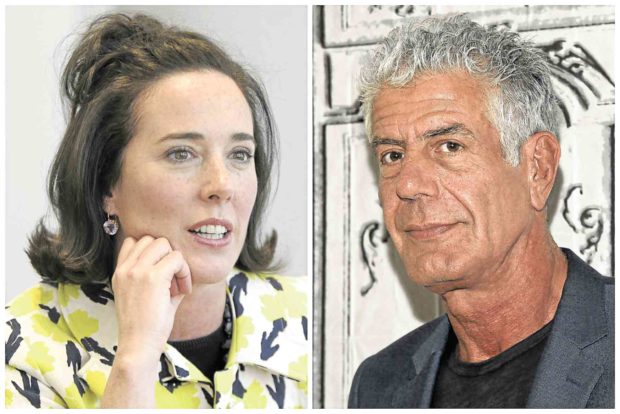Suicide of man ‘with best job in the world’ stuns fans
NEW YORK — Many people thought Anthony Bourdain had the most enviable career in existence. He didn’t deny it.
“I have the best job in the world,” the globe-trotting food-taster and culinary storyteller once told the New Yorker magazine, stating the rather obvious. “If I’m unhappy, it’s a failure of imagination.”
Bourdain’s stunned fans were mourning the loss of that singular imagination on Friday following his death from an apparent suicide, recalling everything from his fearless consumption of a beating cobra’s heart or a sheep testicle to his outspoken support of the #MeToo movement.
“I want it all,” he wrote in his breakthrough 2000 memoir, “Kitchen Confidential.” “I want to try everything once.”
200 days of travel
Article continues after this advertisementAnd it seemed that he pretty much accomplished that, traveling the globe some 200 days a year for his TV shows, reveling not in fancy tasting menus but in simple pleasures like a cold beer and spicy noodles in Hanoi.
Article continues after this advertisementFor him, food, though a huge pleasure, was more importantly a storytelling tool, and a passport to the world at large.
It was a lifestyle that, while undeniably glamorous, took a toll, he suggested in a 2017 New Yorker profile.
“I change location every two weeks,” he said. “I’m not going to remember your birthday. I’m not going to be there for the important moments in your life.”
‘He had everything’
Not surprisingly, it was on the road, in eastern France, that Bourdain, 61, was found unresponsive Friday morning by good friend and chef Eric Ripert in a luxury hotel in Kaysersberg.
He left behind an 11-year-old daughter, Ariane, whose birth, he said in 2008, changed his outlook on life: “I feel obliged to at least do the best I can and not do anything really stupidly self-destructive if I can avoid it.”
At the time of his death, his girlfriend was Asia Argento, the Italian actress who has accused Harvey Weinstein of rape.
Bourdain’s mother, Gladys Bourdain, a longtime editor at The New York Times, said she had no indication that her son might have been thinking of suicide.
“He is absolutely the last person in the world I would have ever dreamed would do something like this,” she told the Times. “He had everything. Success beyond his wildest dreams. Money beyond his wildest dreams.”
More suicides in America
But according to a new US government report released Thursday, suicide rates inched up in nearly every US state from 1999 through 2016.
More than half of suicides in 2015 in a subgroup of 27 states were among people with no known mental health condition, the Centers for Disease Control (CDC) and Prevention found.
Suicide is rarely caused by any single factor, health officials said, but information from coroners’ reports suggest many of the deaths followed relationship problems, substance use and financial crises.
More than a mental health issue
Prevention efforts, often focused on mental health, could be broadened to focus on people undergoing life stresses like job losses or divorces, said Dr. Anne Schuchat of the CDC.
“Suicide is more than a mental health issue,” Schuchat said. “We don’t think we can just leave this to the mental health system to manage.”
Suicide is the 10th leading cause of death and one of just three leading causes that are on the rise. The others are Alzheimer’s disease and drug overdoses.
There were nearly 45,000 suicides in 2016. Middle-aged adults—ages 45 to 64—had the largest rate increase, rising to 19.2 per 100,000 in 2016 from 13.2 per 100,000 in 1999.
The report said people without known mental health problems were more likely to die by firearms than those with known mental health problems.
Immediate steps
Family members or friends concerned about someone who is struggling can ask directly about suicide and remove firearms or any other means the person is considering from the home, said Jennifer Stuber, director of Forefront Suicide Prevention at the University of Washington in Seattle.
Prevention efforts are best done when “people can get help solving the underlying drivers of the problems causing them to feel hopeless and despair,” Stuber said.
The CDC report comes at a time of heightened attention to the issue with the suicide this week of designer Kate Spade. The designer’s husband, Andy Spade, has said she suffered from depression and anxiety for many years.
Overall, the rate rose to 15.4 per 100,000 in 2014-2016 from 12.3 per 100,000 in 1999-2001. Rates ranged from 6.9 per 100,000 in the District of Columbia to 29.2 per 100,000 in Montana.
Twenty-five states saw percentage rate increases of more than 30 percent over 17 years.
The overall data came from coded death certificate records. The information on contributing factors reflect what family and friends told coroners and police in a subgroup of states participating in the CDC’s National Violent Death Reporting System.
In the one-year analysis of 27 states, opioids were found in 31 percent of the 3,003 suicides involving drug overdoses.
The CDC said the 27 states represent nearly half the US population but cannot be considered nationally representative.
If you or someone you know is in need of assistance, please reach out to the National Center for Mental Health (NCMH). Their crisis hotlines are available at 1553 (Luzon-wide landline toll-free), 0917-899-USAP (8727), 0966-351-4518, and 0908-639-2672. For more information, visit their website: (https://doh.gov.ph/NCMH-Crisis-Hotline)
Alternatively, you can contact Hopeline PH at the following numbers: 0917-5584673, 0918-8734673, 88044673. Additional resources are available at ngf-mindstrong.org, or connect with them on Facebook at Hopeline PH.
